Short and Long Term Health Effects of Parental Tobacco Smoking
VerifiedAdded on 2021/06/15
|11
|2822
|150
AI Summary
Contribute Materials
Your contribution can guide someone’s learning journey. Share your
documents today.

Running head: RESEARCH PLAN 1
Research Plan
Name:
Institution Affiliation:
Research Plan
Name:
Institution Affiliation:
Secure Best Marks with AI Grader
Need help grading? Try our AI Grader for instant feedback on your assignments.

RESEARCH PLAN 2
Introduction
Smoking while pregnant is amongst the leading cause to the high maternal and infant mortality
rate in Sydney. Moreover, it is the primary cause to the abnormal birth weight and the health
disorders among the babies. In Australia, tobacco smoking incidents among aboriginal residents
has been consistently higher in comparison to their non-aboriginal peers (Gould et al., 2013).
According the author, females in the reproductive phase are increasingly susceptible to more
detrimental effects from smoking when they get become pregnant (Ploit and Beck, 2017, p.544).
In Australia, smoking is regarded to be the leading risk factor for expectant women and newborn
children (Gould et al., 2017). Smoking women often give birth to children who have long-
standing deleterious effects even when they become adults, therefore the aim of this research
plan aims to address on the experiences and perceptions towards smoking of the indigenous
women on the Acute Inpatient Psychiatric unit in Sydney South West Local health District ,
New South Wales.
Objective
The objective of the research is to provide knowledge to the pregnant women to enable them
acquire more knowledge and develop motivation to integrate it into their behavior (Ploit and
Beck, 2017, p.544). Thus, this research would help to verify the knowledge acquired in order to
understand how pregnant women in less advantaged socioeconomic backgrounds from New
South Wales differ from women from high socioeconomic background in their perceptions
towards smoking during pregnancy.
Research question
The research question for this research study is as follows;
Introduction
Smoking while pregnant is amongst the leading cause to the high maternal and infant mortality
rate in Sydney. Moreover, it is the primary cause to the abnormal birth weight and the health
disorders among the babies. In Australia, tobacco smoking incidents among aboriginal residents
has been consistently higher in comparison to their non-aboriginal peers (Gould et al., 2013).
According the author, females in the reproductive phase are increasingly susceptible to more
detrimental effects from smoking when they get become pregnant (Ploit and Beck, 2017, p.544).
In Australia, smoking is regarded to be the leading risk factor for expectant women and newborn
children (Gould et al., 2017). Smoking women often give birth to children who have long-
standing deleterious effects even when they become adults, therefore the aim of this research
plan aims to address on the experiences and perceptions towards smoking of the indigenous
women on the Acute Inpatient Psychiatric unit in Sydney South West Local health District ,
New South Wales.
Objective
The objective of the research is to provide knowledge to the pregnant women to enable them
acquire more knowledge and develop motivation to integrate it into their behavior (Ploit and
Beck, 2017, p.544). Thus, this research would help to verify the knowledge acquired in order to
understand how pregnant women in less advantaged socioeconomic backgrounds from New
South Wales differ from women from high socioeconomic background in their perceptions
towards smoking during pregnancy.
Research question
The research question for this research study is as follows;
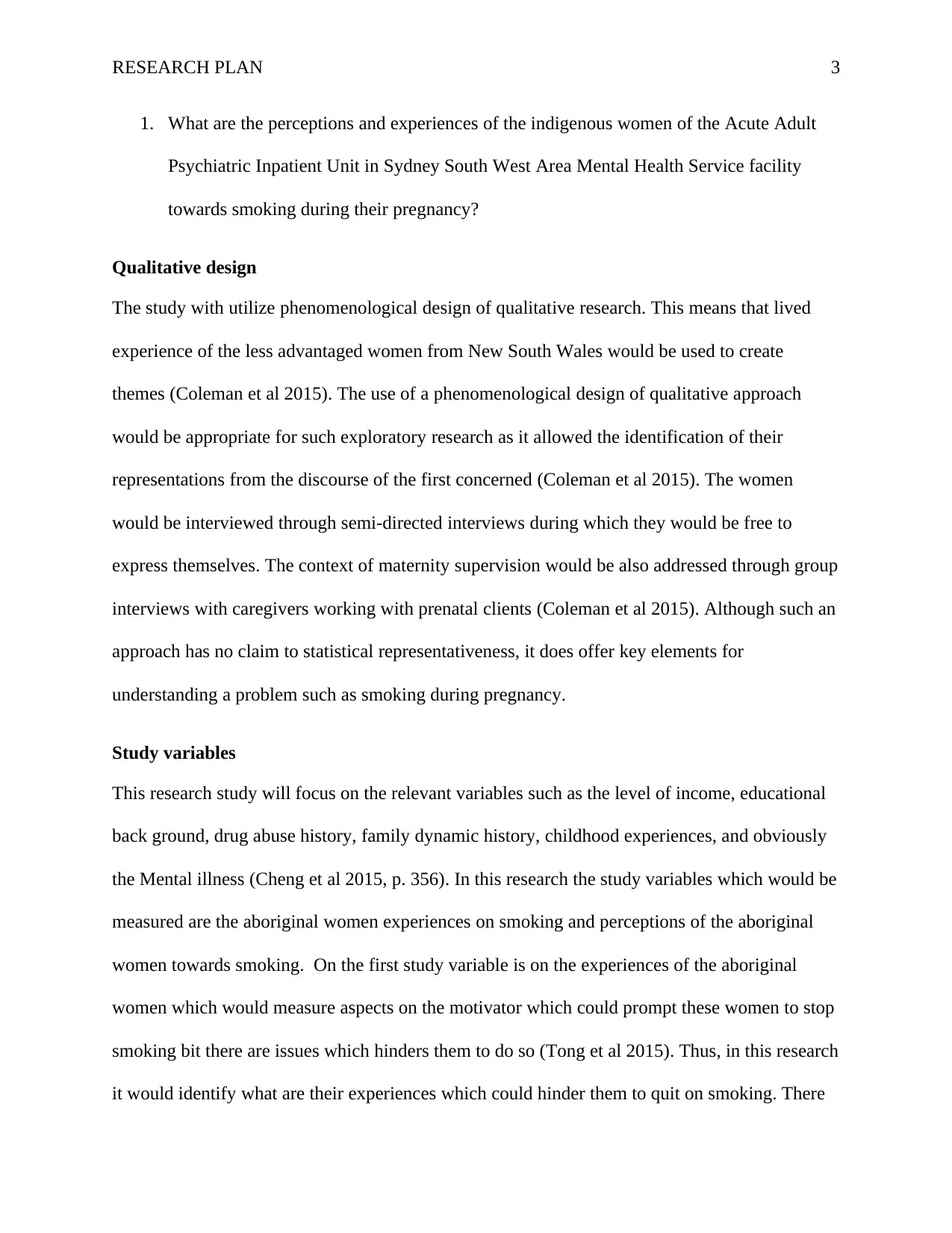
RESEARCH PLAN 3
1. What are the perceptions and experiences of the indigenous women of the Acute Adult
Psychiatric Inpatient Unit in Sydney South West Area Mental Health Service facility
towards smoking during their pregnancy?
Qualitative design
The study with utilize phenomenological design of qualitative research. This means that lived
experience of the less advantaged women from New South Wales would be used to create
themes (Coleman et al 2015). The use of a phenomenological design of qualitative approach
would be appropriate for such exploratory research as it allowed the identification of their
representations from the discourse of the first concerned (Coleman et al 2015). The women
would be interviewed through semi-directed interviews during which they would be free to
express themselves. The context of maternity supervision would be also addressed through group
interviews with caregivers working with prenatal clients (Coleman et al 2015). Although such an
approach has no claim to statistical representativeness, it does offer key elements for
understanding a problem such as smoking during pregnancy.
Study variables
This research study will focus on the relevant variables such as the level of income, educational
back ground, drug abuse history, family dynamic history, childhood experiences, and obviously
the Mental illness (Cheng et al 2015, p. 356). In this research the study variables which would be
measured are the aboriginal women experiences on smoking and perceptions of the aboriginal
women towards smoking. On the first study variable is on the experiences of the aboriginal
women which would measure aspects on the motivator which could prompt these women to stop
smoking bit there are issues which hinders them to do so (Tong et al 2015). Thus, in this research
it would identify what are their experiences which could hinder them to quit on smoking. There
1. What are the perceptions and experiences of the indigenous women of the Acute Adult
Psychiatric Inpatient Unit in Sydney South West Area Mental Health Service facility
towards smoking during their pregnancy?
Qualitative design
The study with utilize phenomenological design of qualitative research. This means that lived
experience of the less advantaged women from New South Wales would be used to create
themes (Coleman et al 2015). The use of a phenomenological design of qualitative approach
would be appropriate for such exploratory research as it allowed the identification of their
representations from the discourse of the first concerned (Coleman et al 2015). The women
would be interviewed through semi-directed interviews during which they would be free to
express themselves. The context of maternity supervision would be also addressed through group
interviews with caregivers working with prenatal clients (Coleman et al 2015). Although such an
approach has no claim to statistical representativeness, it does offer key elements for
understanding a problem such as smoking during pregnancy.
Study variables
This research study will focus on the relevant variables such as the level of income, educational
back ground, drug abuse history, family dynamic history, childhood experiences, and obviously
the Mental illness (Cheng et al 2015, p. 356). In this research the study variables which would be
measured are the aboriginal women experiences on smoking and perceptions of the aboriginal
women towards smoking. On the first study variable is on the experiences of the aboriginal
women which would measure aspects on the motivator which could prompt these women to stop
smoking bit there are issues which hinders them to do so (Tong et al 2015). Thus, in this research
it would identify what are their experiences which could hinder them to quit on smoking. There
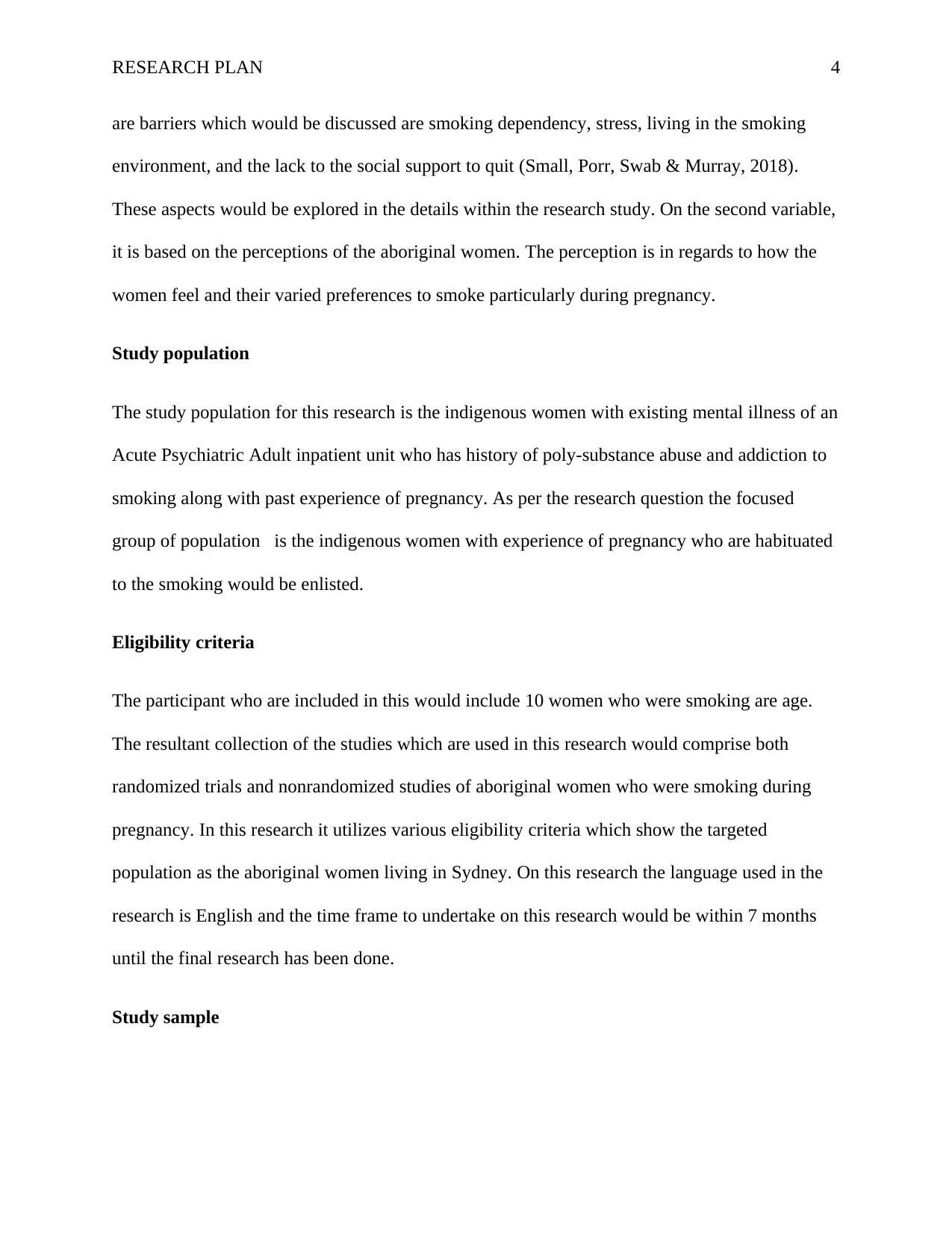
RESEARCH PLAN 4
are barriers which would be discussed are smoking dependency, stress, living in the smoking
environment, and the lack to the social support to quit (Small, Porr, Swab & Murray, 2018).
These aspects would be explored in the details within the research study. On the second variable,
it is based on the perceptions of the aboriginal women. The perception is in regards to how the
women feel and their varied preferences to smoke particularly during pregnancy.
Study population
The study population for this research is the indigenous women with existing mental illness of an
Acute Psychiatric Adult inpatient unit who has history of poly-substance abuse and addiction to
smoking along with past experience of pregnancy. As per the research question the focused
group of population is the indigenous women with experience of pregnancy who are habituated
to the smoking would be enlisted.
Eligibility criteria
The participant who are included in this would include 10 women who were smoking are age.
The resultant collection of the studies which are used in this research would comprise both
randomized trials and nonrandomized studies of aboriginal women who were smoking during
pregnancy. In this research it utilizes various eligibility criteria which show the targeted
population as the aboriginal women living in Sydney. On this research the language used in the
research is English and the time frame to undertake on this research would be within 7 months
until the final research has been done.
Study sample
are barriers which would be discussed are smoking dependency, stress, living in the smoking
environment, and the lack to the social support to quit (Small, Porr, Swab & Murray, 2018).
These aspects would be explored in the details within the research study. On the second variable,
it is based on the perceptions of the aboriginal women. The perception is in regards to how the
women feel and their varied preferences to smoke particularly during pregnancy.
Study population
The study population for this research is the indigenous women with existing mental illness of an
Acute Psychiatric Adult inpatient unit who has history of poly-substance abuse and addiction to
smoking along with past experience of pregnancy. As per the research question the focused
group of population is the indigenous women with experience of pregnancy who are habituated
to the smoking would be enlisted.
Eligibility criteria
The participant who are included in this would include 10 women who were smoking are age.
The resultant collection of the studies which are used in this research would comprise both
randomized trials and nonrandomized studies of aboriginal women who were smoking during
pregnancy. In this research it utilizes various eligibility criteria which show the targeted
population as the aboriginal women living in Sydney. On this research the language used in the
research is English and the time frame to undertake on this research would be within 7 months
until the final research has been done.
Study sample
Secure Best Marks with AI Grader
Need help grading? Try our AI Grader for instant feedback on your assignments.

RESEARCH PLAN 5
The sample of this research study would be comprised of 200 aboriginal women who are among
Sydney mental facility. The women who are selected for this research have been smoking
currently or in the past when they were pregnant.
Sampling method
Purposive sampling would be used as it is more convenient way to recruit particular group of
indigenous women with mental illness habituated of smoking has experienced the pregnancy, as
the researcher will be involved in selection of specific clients to take part to get rich information
(Polit and Beck 2017). A letter of consent could be delivered to the selected populated group
with the sample copy of the questionnaire that would be utilized within this research together
with the protocol of the researcher. A letter would be also being addressed to the City Health
Officer in Sydney to be able to acquire endorsement and permit to carry out a research in the
selected community in Sydney. As an acute Care unit, the researcher’s role will be introducing
the purpose of the study to the consumer especially after recovery from their mental illness prior
to the Discharge. The interview will be conducted after taking the consent.
Study instruments
Data collection
The data collection would be conducted throughout one year to study the perceptions and the
experiences for the specific group of population with indigenous background. As the researcher
is the Mental Health care clinician would organize the group session to encourage participants to
be involved in collecting data.
Data Analysis
The sample of this research study would be comprised of 200 aboriginal women who are among
Sydney mental facility. The women who are selected for this research have been smoking
currently or in the past when they were pregnant.
Sampling method
Purposive sampling would be used as it is more convenient way to recruit particular group of
indigenous women with mental illness habituated of smoking has experienced the pregnancy, as
the researcher will be involved in selection of specific clients to take part to get rich information
(Polit and Beck 2017). A letter of consent could be delivered to the selected populated group
with the sample copy of the questionnaire that would be utilized within this research together
with the protocol of the researcher. A letter would be also being addressed to the City Health
Officer in Sydney to be able to acquire endorsement and permit to carry out a research in the
selected community in Sydney. As an acute Care unit, the researcher’s role will be introducing
the purpose of the study to the consumer especially after recovery from their mental illness prior
to the Discharge. The interview will be conducted after taking the consent.
Study instruments
Data collection
The data collection would be conducted throughout one year to study the perceptions and the
experiences for the specific group of population with indigenous background. As the researcher
is the Mental Health care clinician would organize the group session to encourage participants to
be involved in collecting data.
Data Analysis
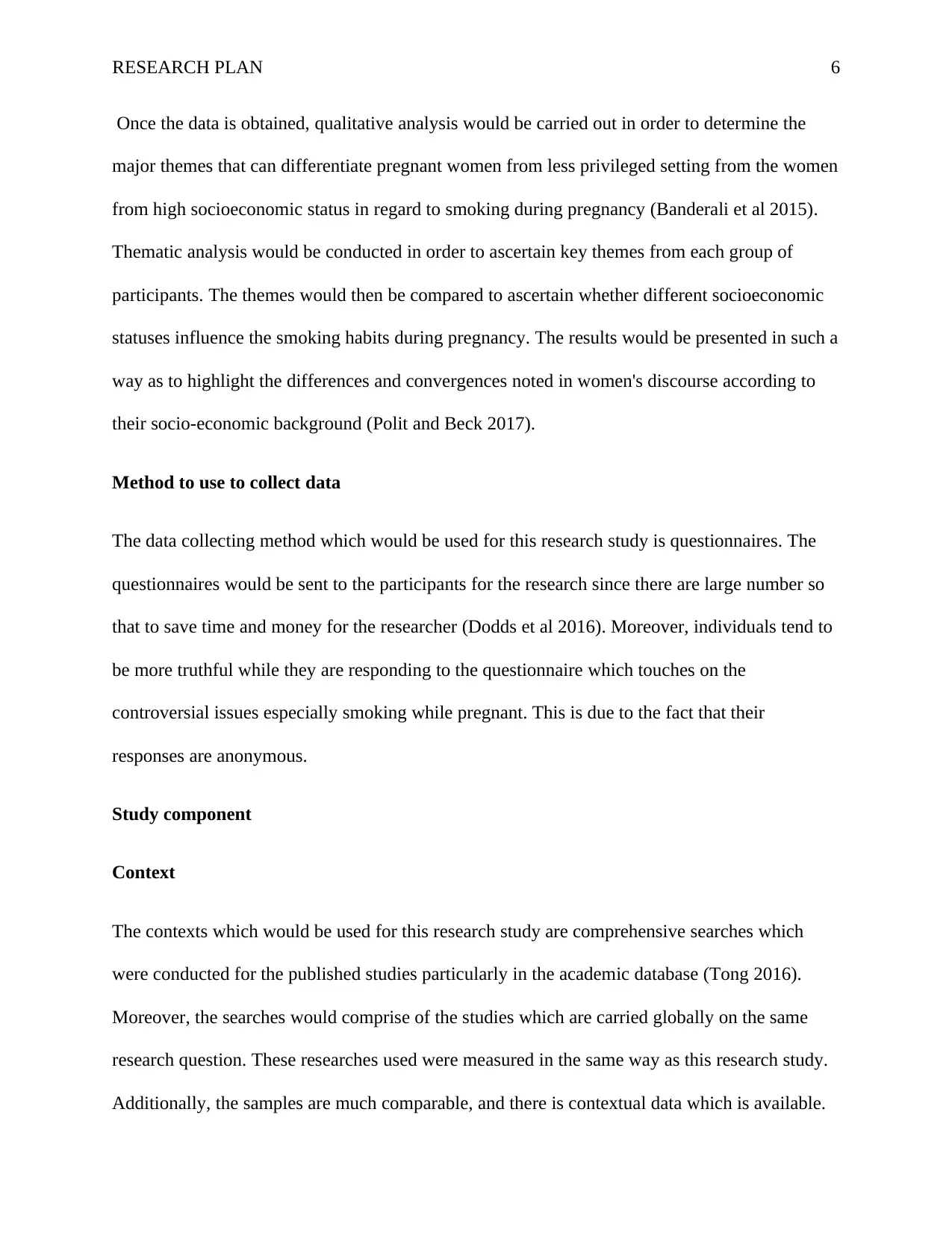
RESEARCH PLAN 6
Once the data is obtained, qualitative analysis would be carried out in order to determine the
major themes that can differentiate pregnant women from less privileged setting from the women
from high socioeconomic status in regard to smoking during pregnancy (Banderali et al 2015).
Thematic analysis would be conducted in order to ascertain key themes from each group of
participants. The themes would then be compared to ascertain whether different socioeconomic
statuses influence the smoking habits during pregnancy. The results would be presented in such a
way as to highlight the differences and convergences noted in women's discourse according to
their socio-economic background (Polit and Beck 2017).
Method to use to collect data
The data collecting method which would be used for this research study is questionnaires. The
questionnaires would be sent to the participants for the research since there are large number so
that to save time and money for the researcher (Dodds et al 2016). Moreover, individuals tend to
be more truthful while they are responding to the questionnaire which touches on the
controversial issues especially smoking while pregnant. This is due to the fact that their
responses are anonymous.
Study component
Context
The contexts which would be used for this research study are comprehensive searches which
were conducted for the published studies particularly in the academic database (Tong 2016).
Moreover, the searches would comprise of the studies which are carried globally on the same
research question. These researches used were measured in the same way as this research study.
Additionally, the samples are much comparable, and there is contextual data which is available.
Once the data is obtained, qualitative analysis would be carried out in order to determine the
major themes that can differentiate pregnant women from less privileged setting from the women
from high socioeconomic status in regard to smoking during pregnancy (Banderali et al 2015).
Thematic analysis would be conducted in order to ascertain key themes from each group of
participants. The themes would then be compared to ascertain whether different socioeconomic
statuses influence the smoking habits during pregnancy. The results would be presented in such a
way as to highlight the differences and convergences noted in women's discourse according to
their socio-economic background (Polit and Beck 2017).
Method to use to collect data
The data collecting method which would be used for this research study is questionnaires. The
questionnaires would be sent to the participants for the research since there are large number so
that to save time and money for the researcher (Dodds et al 2016). Moreover, individuals tend to
be more truthful while they are responding to the questionnaire which touches on the
controversial issues especially smoking while pregnant. This is due to the fact that their
responses are anonymous.
Study component
Context
The contexts which would be used for this research study are comprehensive searches which
were conducted for the published studies particularly in the academic database (Tong 2016).
Moreover, the searches would comprise of the studies which are carried globally on the same
research question. These researches used were measured in the same way as this research study.
Additionally, the samples are much comparable, and there is contextual data which is available.
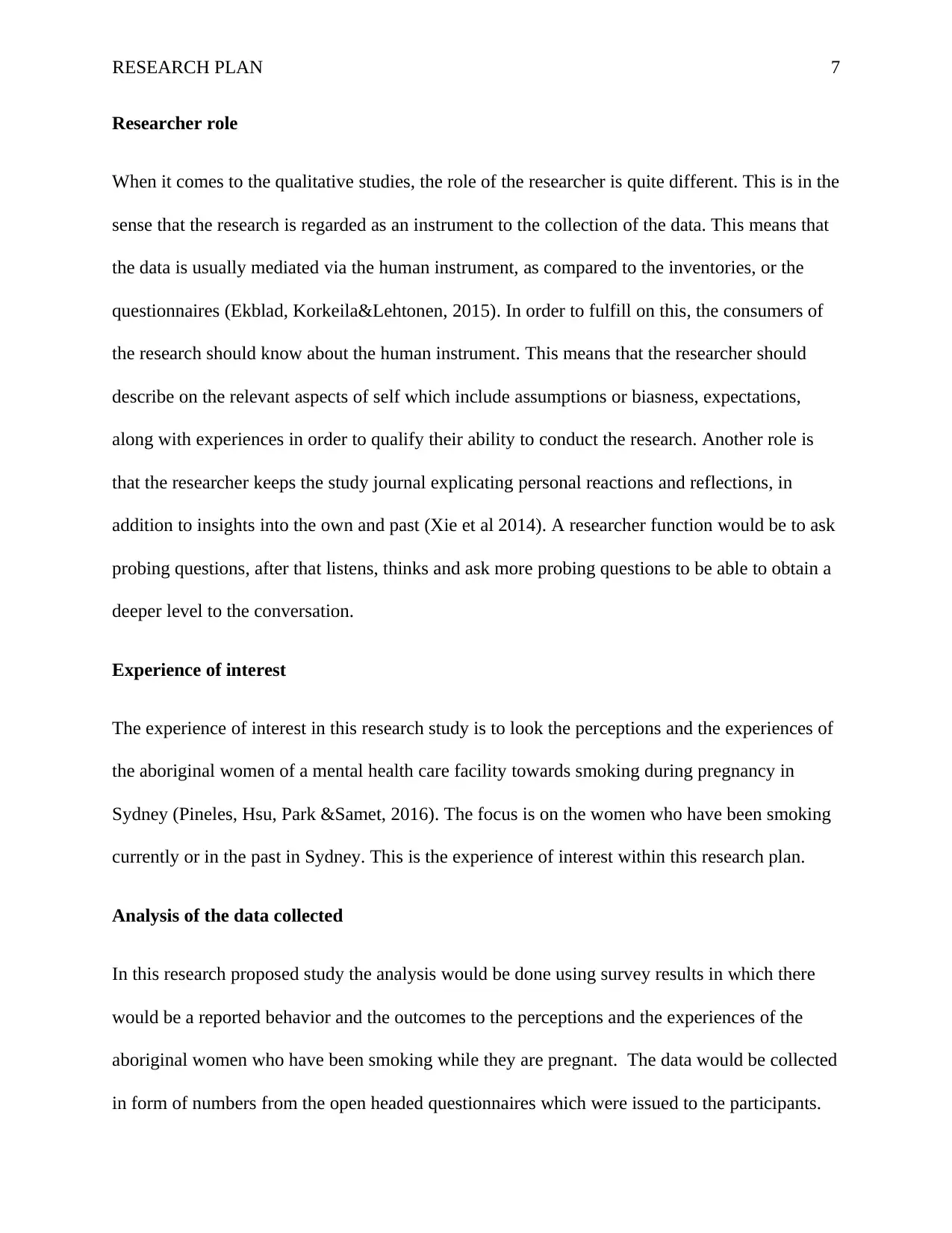
RESEARCH PLAN 7
Researcher role
When it comes to the qualitative studies, the role of the researcher is quite different. This is in the
sense that the research is regarded as an instrument to the collection of the data. This means that
the data is usually mediated via the human instrument, as compared to the inventories, or the
questionnaires (Ekblad, Korkeila&Lehtonen, 2015). In order to fulfill on this, the consumers of
the research should know about the human instrument. This means that the researcher should
describe on the relevant aspects of self which include assumptions or biasness, expectations,
along with experiences in order to qualify their ability to conduct the research. Another role is
that the researcher keeps the study journal explicating personal reactions and reflections, in
addition to insights into the own and past (Xie et al 2014). A researcher function would be to ask
probing questions, after that listens, thinks and ask more probing questions to be able to obtain a
deeper level to the conversation.
Experience of interest
The experience of interest in this research study is to look the perceptions and the experiences of
the aboriginal women of a mental health care facility towards smoking during pregnancy in
Sydney (Pineles, Hsu, Park &Samet, 2016). The focus is on the women who have been smoking
currently or in the past in Sydney. This is the experience of interest within this research plan.
Analysis of the data collected
In this research proposed study the analysis would be done using survey results in which there
would be a reported behavior and the outcomes to the perceptions and the experiences of the
aboriginal women who have been smoking while they are pregnant. The data would be collected
in form of numbers from the open headed questionnaires which were issued to the participants.
Researcher role
When it comes to the qualitative studies, the role of the researcher is quite different. This is in the
sense that the research is regarded as an instrument to the collection of the data. This means that
the data is usually mediated via the human instrument, as compared to the inventories, or the
questionnaires (Ekblad, Korkeila&Lehtonen, 2015). In order to fulfill on this, the consumers of
the research should know about the human instrument. This means that the researcher should
describe on the relevant aspects of self which include assumptions or biasness, expectations,
along with experiences in order to qualify their ability to conduct the research. Another role is
that the researcher keeps the study journal explicating personal reactions and reflections, in
addition to insights into the own and past (Xie et al 2014). A researcher function would be to ask
probing questions, after that listens, thinks and ask more probing questions to be able to obtain a
deeper level to the conversation.
Experience of interest
The experience of interest in this research study is to look the perceptions and the experiences of
the aboriginal women of a mental health care facility towards smoking during pregnancy in
Sydney (Pineles, Hsu, Park &Samet, 2016). The focus is on the women who have been smoking
currently or in the past in Sydney. This is the experience of interest within this research plan.
Analysis of the data collected
In this research proposed study the analysis would be done using survey results in which there
would be a reported behavior and the outcomes to the perceptions and the experiences of the
aboriginal women who have been smoking while they are pregnant. The data would be collected
in form of numbers from the open headed questionnaires which were issued to the participants.
Paraphrase This Document
Need a fresh take? Get an instant paraphrase of this document with our AI Paraphraser
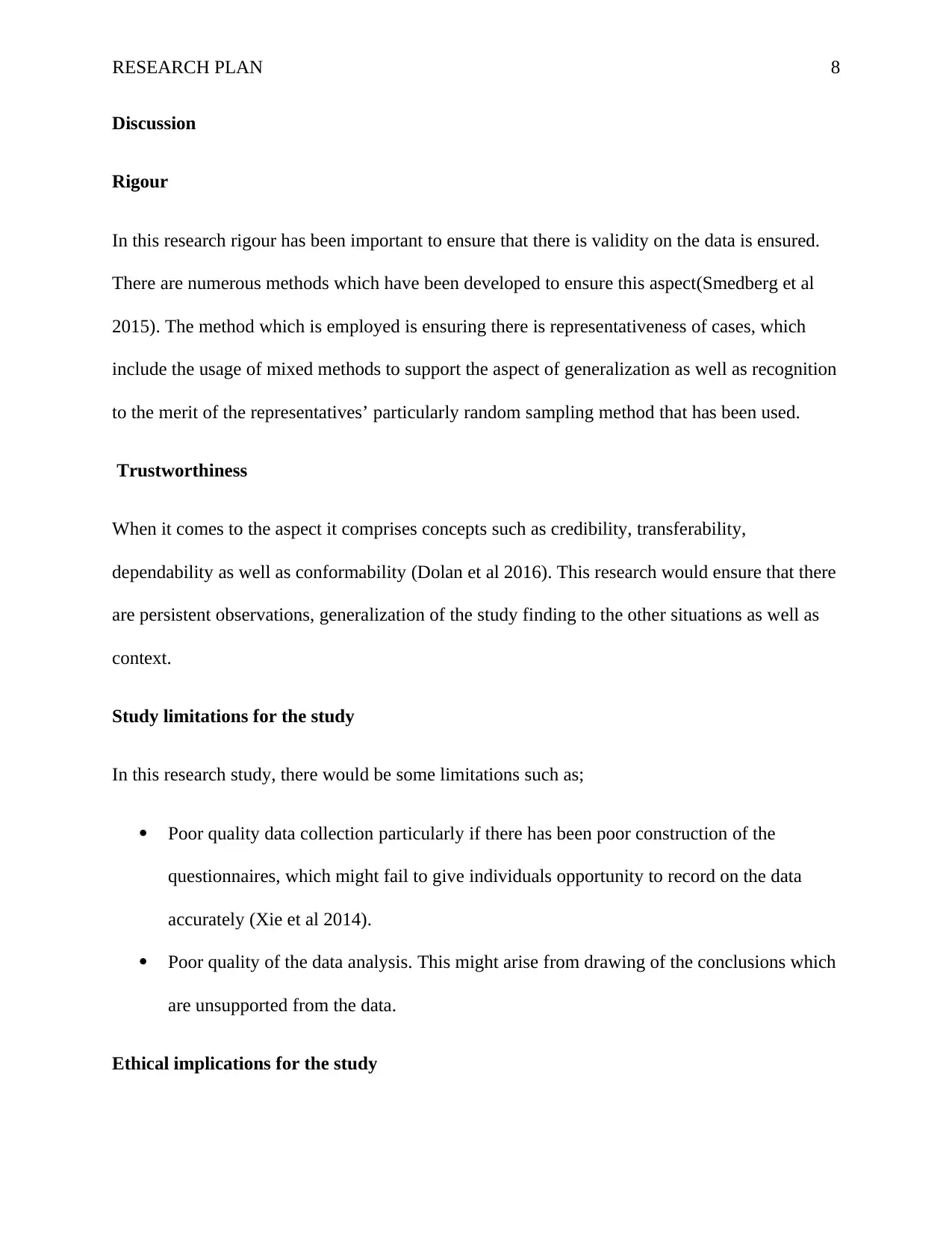
RESEARCH PLAN 8
Discussion
Rigour
In this research rigour has been important to ensure that there is validity on the data is ensured.
There are numerous methods which have been developed to ensure this aspect(Smedberg et al
2015). The method which is employed is ensuring there is representativeness of cases, which
include the usage of mixed methods to support the aspect of generalization as well as recognition
to the merit of the representatives’ particularly random sampling method that has been used.
Trustworthiness
When it comes to the aspect it comprises concepts such as credibility, transferability,
dependability as well as conformability (Dolan et al 2016). This research would ensure that there
are persistent observations, generalization of the study finding to the other situations as well as
context.
Study limitations for the study
In this research study, there would be some limitations such as;
Poor quality data collection particularly if there has been poor construction of the
questionnaires, which might fail to give individuals opportunity to record on the data
accurately (Xie et al 2014).
Poor quality of the data analysis. This might arise from drawing of the conclusions which
are unsupported from the data.
Ethical implications for the study
Discussion
Rigour
In this research rigour has been important to ensure that there is validity on the data is ensured.
There are numerous methods which have been developed to ensure this aspect(Smedberg et al
2015). The method which is employed is ensuring there is representativeness of cases, which
include the usage of mixed methods to support the aspect of generalization as well as recognition
to the merit of the representatives’ particularly random sampling method that has been used.
Trustworthiness
When it comes to the aspect it comprises concepts such as credibility, transferability,
dependability as well as conformability (Dolan et al 2016). This research would ensure that there
are persistent observations, generalization of the study finding to the other situations as well as
context.
Study limitations for the study
In this research study, there would be some limitations such as;
Poor quality data collection particularly if there has been poor construction of the
questionnaires, which might fail to give individuals opportunity to record on the data
accurately (Xie et al 2014).
Poor quality of the data analysis. This might arise from drawing of the conclusions which
are unsupported from the data.
Ethical implications for the study
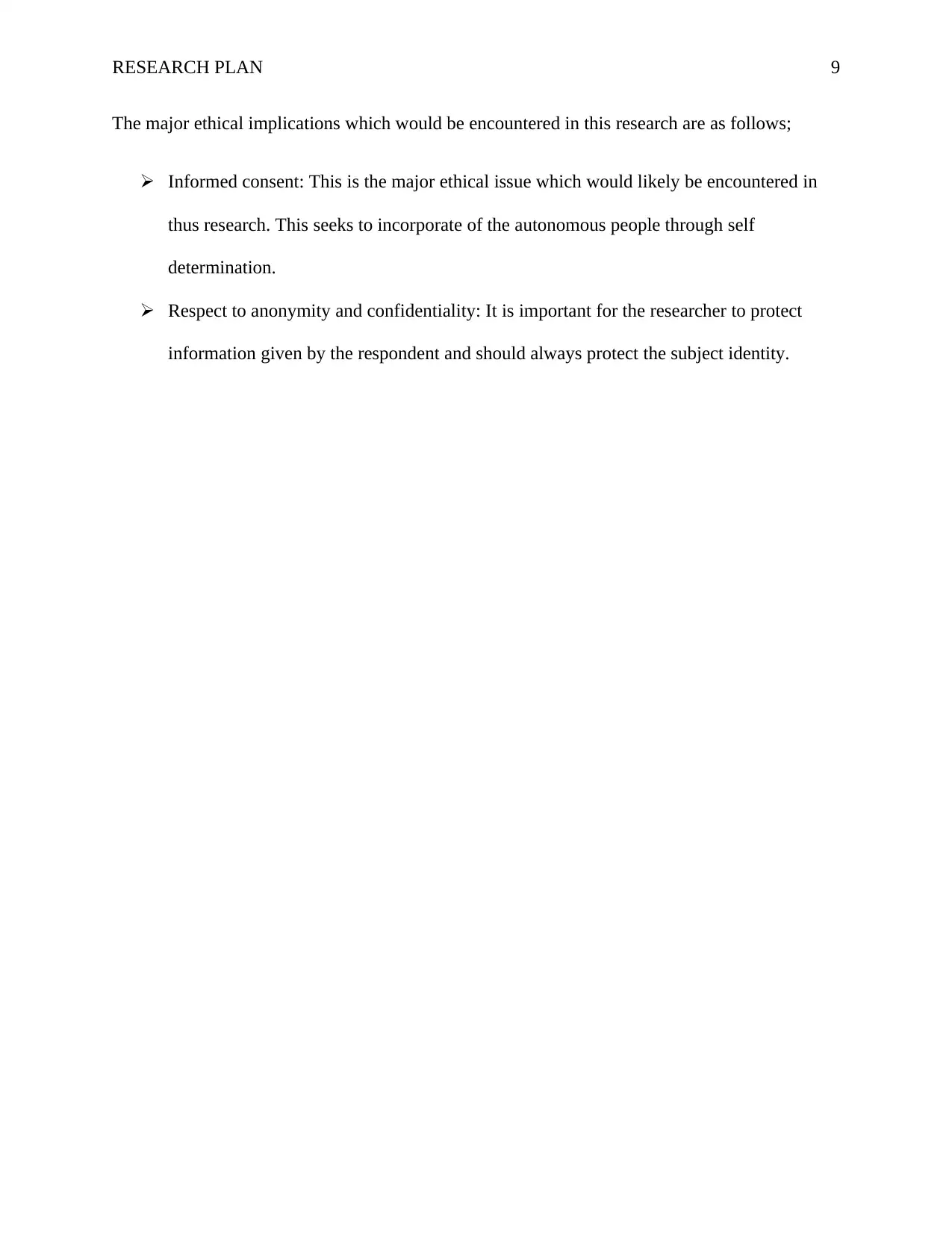
RESEARCH PLAN 9
The major ethical implications which would be encountered in this research are as follows;
Informed consent: This is the major ethical issue which would likely be encountered in
thus research. This seeks to incorporate of the autonomous people through self
determination.
Respect to anonymity and confidentiality: It is important for the researcher to protect
information given by the respondent and should always protect the subject identity.
The major ethical implications which would be encountered in this research are as follows;
Informed consent: This is the major ethical issue which would likely be encountered in
thus research. This seeks to incorporate of the autonomous people through self
determination.
Respect to anonymity and confidentiality: It is important for the researcher to protect
information given by the respondent and should always protect the subject identity.
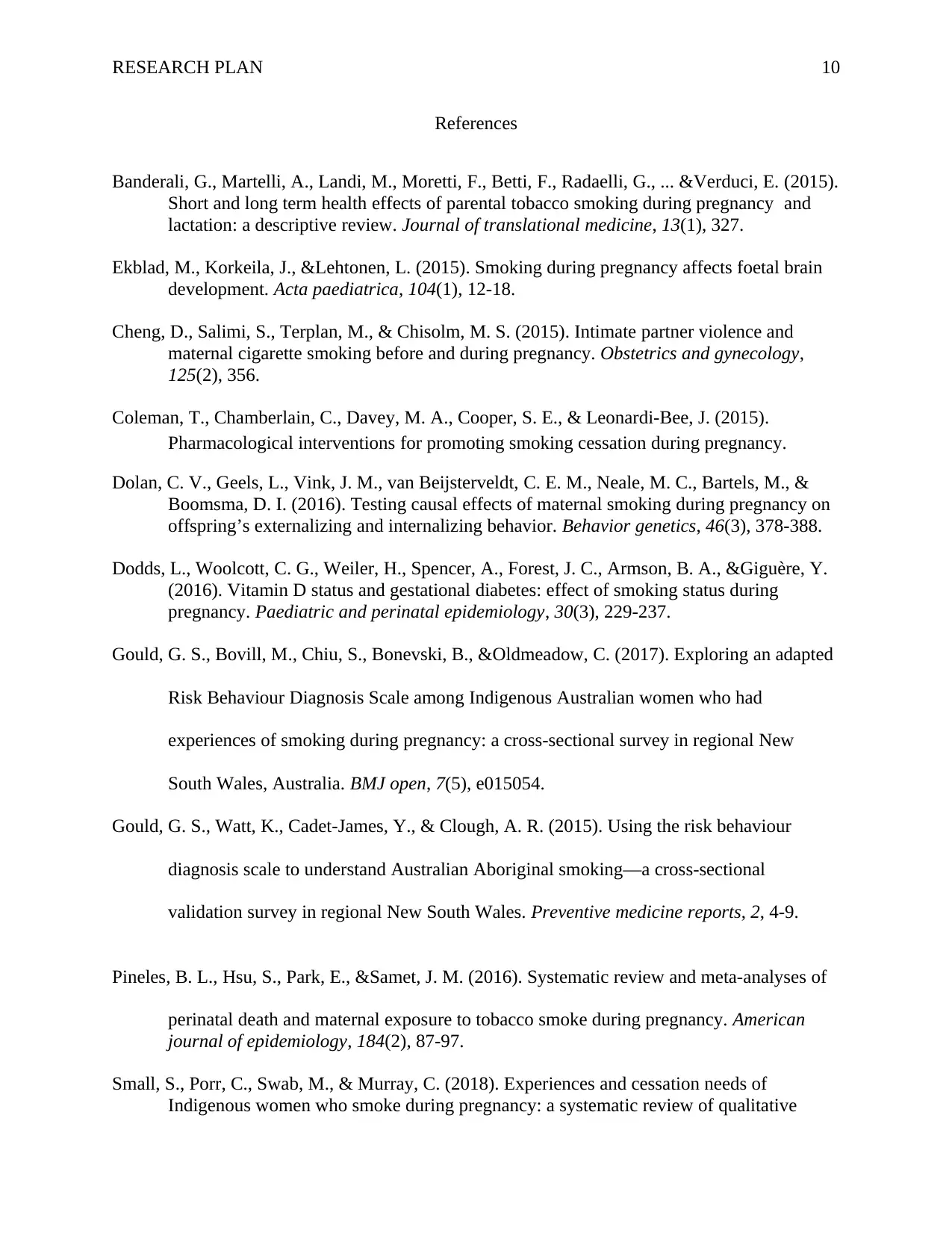
RESEARCH PLAN 10
References
Banderali, G., Martelli, A., Landi, M., Moretti, F., Betti, F., Radaelli, G., ... &Verduci, E. (2015).
Short and long term health effects of parental tobacco smoking during pregnancy and
lactation: a descriptive review. Journal of translational medicine, 13(1), 327.
Ekblad, M., Korkeila, J., &Lehtonen, L. (2015). Smoking during pregnancy affects foetal brain
development. Acta paediatrica, 104(1), 12-18.
Cheng, D., Salimi, S., Terplan, M., & Chisolm, M. S. (2015). Intimate partner violence and
maternal cigarette smoking before and during pregnancy. Obstetrics and gynecology,
125(2), 356.
Coleman, T., Chamberlain, C., Davey, M. A., Cooper, S. E., & Leonardi-Bee, J. (2015).
Pharmacological interventions for promoting smoking cessation during pregnancy.
Dolan, C. V., Geels, L., Vink, J. M., van Beijsterveldt, C. E. M., Neale, M. C., Bartels, M., &
Boomsma, D. I. (2016). Testing causal effects of maternal smoking during pregnancy on
offspring’s externalizing and internalizing behavior. Behavior genetics, 46(3), 378-388.
Dodds, L., Woolcott, C. G., Weiler, H., Spencer, A., Forest, J. C., Armson, B. A., &Giguère, Y.
(2016). Vitamin D status and gestational diabetes: effect of smoking status during
pregnancy. Paediatric and perinatal epidemiology, 30(3), 229-237.
Gould, G. S., Bovill, M., Chiu, S., Bonevski, B., &Oldmeadow, C. (2017). Exploring an adapted
Risk Behaviour Diagnosis Scale among Indigenous Australian women who had
experiences of smoking during pregnancy: a cross-sectional survey in regional New
South Wales, Australia. BMJ open, 7(5), e015054.
Gould, G. S., Watt, K., Cadet-James, Y., & Clough, A. R. (2015). Using the risk behaviour
diagnosis scale to understand Australian Aboriginal smoking—a cross-sectional
validation survey in regional New South Wales. Preventive medicine reports, 2, 4-9.
Pineles, B. L., Hsu, S., Park, E., &Samet, J. M. (2016). Systematic review and meta-analyses of
perinatal death and maternal exposure to tobacco smoke during pregnancy. American
journal of epidemiology, 184(2), 87-97.
Small, S., Porr, C., Swab, M., & Murray, C. (2018). Experiences and cessation needs of
Indigenous women who smoke during pregnancy: a systematic review of qualitative
References
Banderali, G., Martelli, A., Landi, M., Moretti, F., Betti, F., Radaelli, G., ... &Verduci, E. (2015).
Short and long term health effects of parental tobacco smoking during pregnancy and
lactation: a descriptive review. Journal of translational medicine, 13(1), 327.
Ekblad, M., Korkeila, J., &Lehtonen, L. (2015). Smoking during pregnancy affects foetal brain
development. Acta paediatrica, 104(1), 12-18.
Cheng, D., Salimi, S., Terplan, M., & Chisolm, M. S. (2015). Intimate partner violence and
maternal cigarette smoking before and during pregnancy. Obstetrics and gynecology,
125(2), 356.
Coleman, T., Chamberlain, C., Davey, M. A., Cooper, S. E., & Leonardi-Bee, J. (2015).
Pharmacological interventions for promoting smoking cessation during pregnancy.
Dolan, C. V., Geels, L., Vink, J. M., van Beijsterveldt, C. E. M., Neale, M. C., Bartels, M., &
Boomsma, D. I. (2016). Testing causal effects of maternal smoking during pregnancy on
offspring’s externalizing and internalizing behavior. Behavior genetics, 46(3), 378-388.
Dodds, L., Woolcott, C. G., Weiler, H., Spencer, A., Forest, J. C., Armson, B. A., &Giguère, Y.
(2016). Vitamin D status and gestational diabetes: effect of smoking status during
pregnancy. Paediatric and perinatal epidemiology, 30(3), 229-237.
Gould, G. S., Bovill, M., Chiu, S., Bonevski, B., &Oldmeadow, C. (2017). Exploring an adapted
Risk Behaviour Diagnosis Scale among Indigenous Australian women who had
experiences of smoking during pregnancy: a cross-sectional survey in regional New
South Wales, Australia. BMJ open, 7(5), e015054.
Gould, G. S., Watt, K., Cadet-James, Y., & Clough, A. R. (2015). Using the risk behaviour
diagnosis scale to understand Australian Aboriginal smoking—a cross-sectional
validation survey in regional New South Wales. Preventive medicine reports, 2, 4-9.
Pineles, B. L., Hsu, S., Park, E., &Samet, J. M. (2016). Systematic review and meta-analyses of
perinatal death and maternal exposure to tobacco smoke during pregnancy. American
journal of epidemiology, 184(2), 87-97.
Small, S., Porr, C., Swab, M., & Murray, C. (2018). Experiences and cessation needs of
Indigenous women who smoke during pregnancy: a systematic review of qualitative
Secure Best Marks with AI Grader
Need help grading? Try our AI Grader for instant feedback on your assignments.
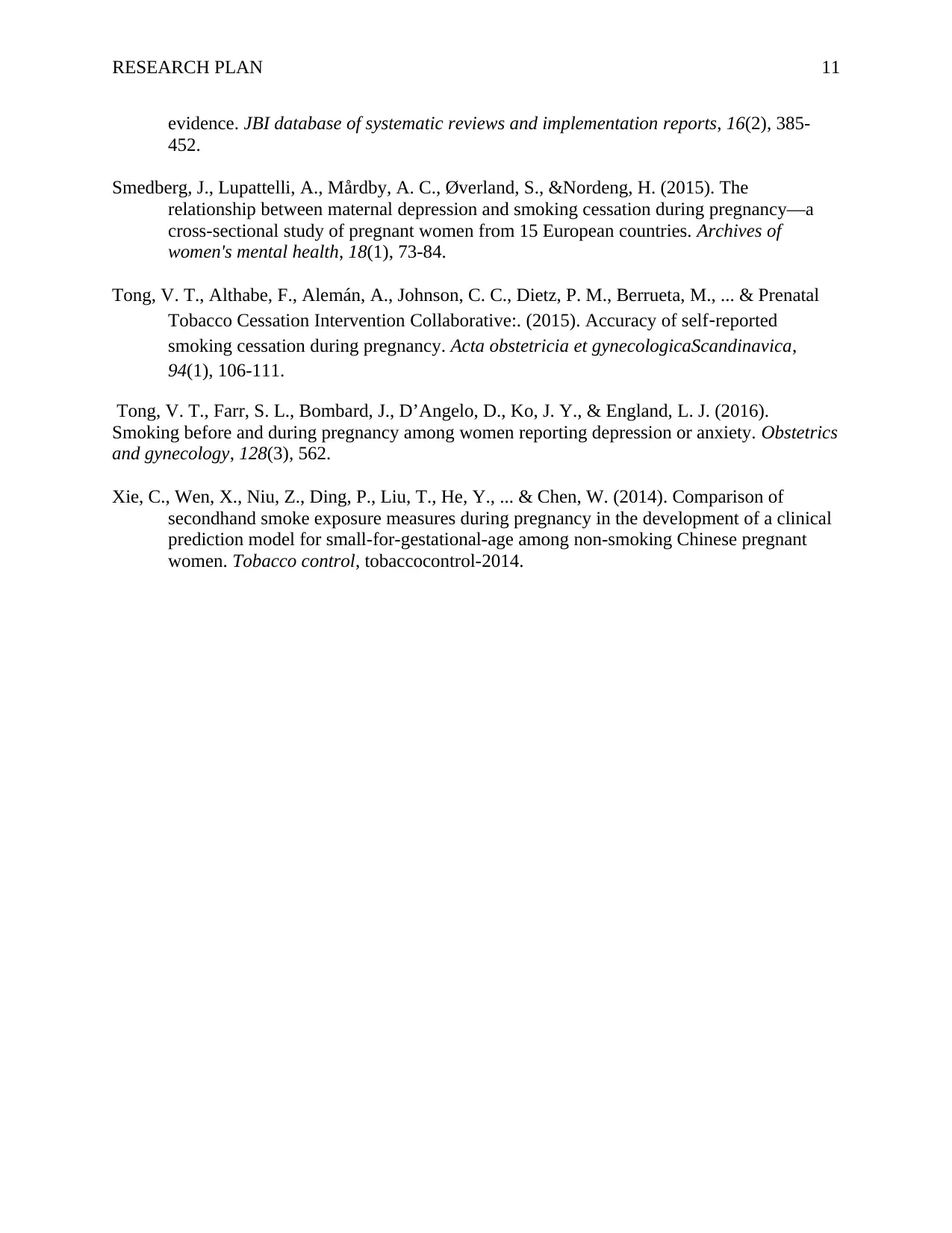
RESEARCH PLAN 11
evidence. JBI database of systematic reviews and implementation reports, 16(2), 385-
452.
Smedberg, J., Lupattelli, A., Mårdby, A. C., Øverland, S., &Nordeng, H. (2015). The
relationship between maternal depression and smoking cessation during pregnancy—a
cross-sectional study of pregnant women from 15 European countries. Archives of
women's mental health, 18(1), 73-84.
Tong, V. T., Althabe, F., Alemán, A., Johnson, C. C., Dietz, P. M., Berrueta, M., ... & Prenatal
Tobacco Cessation Intervention Collaborative:. (2015). Accuracy of self‐reported
smoking cessation during pregnancy. Acta obstetricia et gynecologicaScandinavica,
94(1), 106-111.
Tong, V. T., Farr, S. L., Bombard, J., D’Angelo, D., Ko, J. Y., & England, L. J. (2016).
Smoking before and during pregnancy among women reporting depression or anxiety. Obstetrics
and gynecology, 128(3), 562.
Xie, C., Wen, X., Niu, Z., Ding, P., Liu, T., He, Y., ... & Chen, W. (2014). Comparison of
secondhand smoke exposure measures during pregnancy in the development of a clinical
prediction model for small-for-gestational-age among non-smoking Chinese pregnant
women. Tobacco control, tobaccocontrol-2014.
evidence. JBI database of systematic reviews and implementation reports, 16(2), 385-
452.
Smedberg, J., Lupattelli, A., Mårdby, A. C., Øverland, S., &Nordeng, H. (2015). The
relationship between maternal depression and smoking cessation during pregnancy—a
cross-sectional study of pregnant women from 15 European countries. Archives of
women's mental health, 18(1), 73-84.
Tong, V. T., Althabe, F., Alemán, A., Johnson, C. C., Dietz, P. M., Berrueta, M., ... & Prenatal
Tobacco Cessation Intervention Collaborative:. (2015). Accuracy of self‐reported
smoking cessation during pregnancy. Acta obstetricia et gynecologicaScandinavica,
94(1), 106-111.
Tong, V. T., Farr, S. L., Bombard, J., D’Angelo, D., Ko, J. Y., & England, L. J. (2016).
Smoking before and during pregnancy among women reporting depression or anxiety. Obstetrics
and gynecology, 128(3), 562.
Xie, C., Wen, X., Niu, Z., Ding, P., Liu, T., He, Y., ... & Chen, W. (2014). Comparison of
secondhand smoke exposure measures during pregnancy in the development of a clinical
prediction model for small-for-gestational-age among non-smoking Chinese pregnant
women. Tobacco control, tobaccocontrol-2014.
1 out of 11
Related Documents
Your All-in-One AI-Powered Toolkit for Academic Success.
+13062052269
info@desklib.com
Available 24*7 on WhatsApp / Email
![[object Object]](/_next/static/media/star-bottom.7253800d.svg)
Unlock your academic potential
© 2024 | Zucol Services PVT LTD | All rights reserved.


